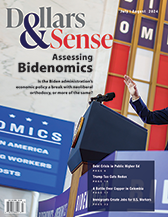Are We on the Verge?
The Jobs Report for June 2024
This article is from Dollars & Sense: Real World Economics, available at http://www.dollarsandsense.org

This is an online-only article.
Subscribe Now
at a 30% discount.
Are we on the precipice of a recession? Some experts think so. Neil Dutta wrote a piece for Business Insider with this title: “We’re on the Brink of an Unemployment Fiasco.” At The American Prospect, the headline for Ryan Cooper’s article revealed a lack of reverence for the Chair of the Federal Reserve: “Inflation is Whipped. Someone Wake Up Jerome Powell.” Cooper wrote not only about the harm that high interest rates levied on job-creation, but also about how high interest rates made our national housing shortage much worse.
Are we close to a recession? Hard to tell. Total economic output—real Gross Domestic Product—has been weak this year—often under 2% growth. But the economy is still growing. Initial unemployment insurance claims, measured as 4-Week averages, were higher in early July than, for example, in early February, but not by a lot. Just 7.4% more claims.
And other indicators give a mixed impression.
- Job openings: They were down by over a million from the total in May of 2023. That’s a negative.
- How about job quits, a possible indicator of how confident workers are about finding new jobs. The raw numbers are down from 2021-2022, but that was an unusual period. The rate of quits is not much different from what it was over 2016-2020. Workers do not seem to be unusually fearful of giving up the jobs they have to take or search for a new position.
- Officially unemployed: 6.8 million (4.1%)
- Hidden unemployment: 10.1 million
- Total: 16.2 million (9.4% of the labor force)
- The official unemployment rate rose a tenth of a point in May to 4.1%. By conventional standards that is not so high, but the number was 3.6% a year ago. Obviously it is moving in the wrong direction. Even Mr. Powell recently admitted that job markets have cooled considerably and that it would be a bad idea to cut interest rates too late. But he did not tell us that cuts would come very soon.
Inflation is pretty much under control at about 3% a year and Americans believe that it will stay about where it is. By the way, Chair Powell prefers a different measure of inflation than our Consumer Price Index and in that one there is even less inflation—just 2.5% a year. So we are about pretty much where he wants us to be. It really is time for Mr. Powell to declare that the war on inflation has been won. Of course, prices could shoot up for some unexpected reason—new supply-chain issues, for example. But deal with that if and when it happens. Right now it is time to boost job growth and programs that make life better for people who are struggling every day just to get by. More demand for things and workers could lift wages a little faster. Real, after-inflation hourly pay for average employees is up just 1% over the last year. - We need millions of new good jobs. The official unemployment rate may be 4.1% but a more realistic rate is the National Jobs for All Network’s estimate that includes hidden unemployment. Our rate is 9.6%. It includes part-timers who want full-time work and people who want jobs but are not currently looking for one. Amongst the latter is a group of 365,000 people who do not think they will find a job. They are called “discouraged” workers.
- We get our unemployment rate and many other useful numbers from a monthly household survey. But we also get information on non-farm employees from a survey of employers. The
reports have not been particularly strong of late and the April and May numbers were revised downward after new information came to the Bureau of Labor Statistics. So jobs added were 206,000 in June, and 108,000 April and 218,000 in May. Not a recession, but pretty low. But such low numbers are not unusual. I checked myself by comparing several January-to-June changes in these job totals and here are six-month changes in the number of jobs:
2013 +0.7%
2018 +0.9%
2024 +0.7%
So that last half a year was not exactly jobs-heaven, but it has not been much worse than a couple of other non-recessionary periods. Non-farm job numbers aren’t close to recessionary. - But even in “good times,” it is clear that we need many more jobs but not just any jobs. Good jobs with decent pay, benefits, and so on. Not enough good jobs can come from low-interest rates or slightly higher minimum-wage laws. Direct job-creation by governments and agents of governments is both a way to get important projects done and to insure that compensation is halfway decent.
The Full Count
June 2024
[There are 2.0 job-wanters for each available job.]
Source: U.S. Bureau of Labor Statistics.
Find the NJFAN's full analysis of the latest unemployment data here.
By the way, here in California we read about how high wages—lifted by a new minimum wage law—are ruining the fast-food sector and other sectors. But we should remember this: $20 an hour for a full year of full-time work is around $40,000. That does not seem like a lot of money in California or elsewhere. Of course, it’s above the federal family poverty line (around $29,000), but that figure is one of the government’s most ludicrous numbers.
Did you find this article useful? Please consider supporting our work by donating or subscribing.
